See also
| Look up cordless in Wiktionary, the free dictionary. |
The term cordless is generally used to refer to electrical or electronic devices that are powered by a battery or battery pack and can operate without a power cord or cable attached to an electrical outlet to provide mains power, allowing greater mobility. [1] The term "cordless" should not be confused with the term "wireless", although it often is in common usage, possibly because some cordless devices (e.g., cordless telephones) are also wireless. The term "wireless" generally refers to devices that use some form of energy (e.g., radio waves, infrared, ultrasonic, etc.) to transfer information or commands over a distance without the use of communication wires, regardless of whether the device gets its power from a power cord or a battery. The term "portable" is an even more general term and, when referring to electrical and electronic devices, usually means devices which are totally self-contained (e.g., have built-in power supplies, have no base unit, etc.) and which may also use wireless technology.
| Look up cordless in Wiktionary, the free dictionary. |

In electronics and telecommunications, a radio transmitter or just transmitter is an electronic device which produces radio waves with an antenna. The transmitter itself generates a radio frequency alternating current, which is applied to the antenna. When excited by this alternating current, the antenna radiates radio waves.
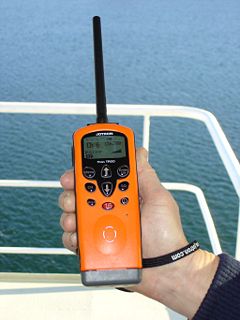
Wireless communication is the transfer of information between two or more points that do not use an electrical conductor as a medium for the transfer. The most common wireless technologies use radio waves. With radio waves, intended distances can be short, such as a few meters for Bluetooth or as far as millions of kilometers for deep-space radio communications. It encompasses various types of fixed, mobile, and portable applications, including two-way radios, cellular telephones, personal digital assistants (PDAs), and wireless networking. Other examples of applications of radio wireless technology include GPS units, garage door openers, wireless computer mouse, keyboards and headsets, headphones, radio receivers, satellite television, broadcast television and cordless telephones. Somewhat less common methods of achieving wireless communications include the use of other electromagnetic wireless technologies, such as light, magnetic, or electric fields or the use of sound.

Headphones are a pair of small loudspeaker drivers worn on or around the head over a user's ears. They are electroacoustic transducers, which convert an electrical signal to a corresponding sound. Headphones let a single user listen to an audio source privately, in contrast to a loudspeaker, which emits sound into the open air for anyone nearby to hear. Headphones are also known as earspeakers, earphones or, colloquially, cans. Circumaural and supra-aural headphones use a band over the top of the head to hold the speakers in place. Another type, known as earbuds or earpieces consist of individual units that plug into the user's ear canal. A third type are bone conduction headphones, which typically wrap around the back of the head and rest in front of the ear canal, leaving the ear canal open. In the context of telecommunication, a headset is a combination of headphone and microphone.
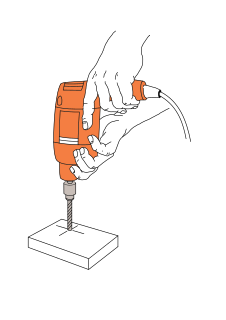
A drill is a tool used for making round holes or driving fasteners. It is fitted with a bit, either a drill or driverchuck. with hand-operated types dramatically decreasing in popularity and cordless battery-powered ones proliferating.

A barcode reader is an optical scanner that can read printed barcodes, decode the data contained in the barcode and send the data to a computer. Like a flatbed scanner, it consists of a light source, a lens and a light sensor translating for optical impulses into electrical signals. Additionally, nearly all barcode readers contain decoder circuitry that can analyze the barcode's image data provided by the sensor and sending the barcode's content to the scanner's output port.

IEC 60320 Appliance couplers for household and similar general purposes is a set of standards from the International Electrotechnical Commission (IEC) specifying non-locking connectors for connecting power supply cords to electrical appliances of voltage not exceeding 250 V (a.c.) and rated current not exceeding 16 A. Different types of connector are specified for different combinations of current, temperature and earthing requirements. Unlike IEC 60309 connectors, they are not coded for voltage; users must ensure that the voltage rating of the equipment is compatible with the mains supply. The standard uses the term coupler to encompass connectors on power cords and power inlets and outlets built into appliances.
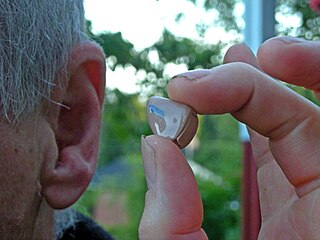
A hearing aid is a device designed to improve hearing by making sound audible to a person with hearing loss. Hearing aids are classified as medical devices in most countries, and regulated by the respective regulations. Small audio amplifiers such as PSAPs or other plain sound reinforcing systems cannot be sold as "hearing aids".

Wireless power transfer (WPT), wireless power transmission, wireless energy transmission (WET), or electromagnetic power transfer is the transmission of electrical energy without wires as a physical link. In a wireless power transmission system, a transmitter device, driven by electric power from a power source, generates a time-varying electromagnetic field, which transmits power across space to a receiver device, which extracts power from the field and supplies it to an electrical load. The technology of wireless power transmission can eliminate the use of the wires and batteries, thus increasing the mobility, convenience, and safety of an electronic device for all users. Wireless power transfer is useful to power electrical devices where interconnecting wires are inconvenient, hazardous, or are not possible.
Code of Federal Regulations, Title 47, Part 15 is an oft-quoted part of Federal Communications Commission (FCC) rules and regulations regarding unlicensed transmissions. It is a part of Title 47 of the Code of Federal Regulations (CFR), and regulates everything from spurious emissions to unlicensed low-power broadcasting. Nearly every electronics device sold inside the United States radiates unintentional emissions, and must be reviewed to comply with Part 15 before it can be advertised or sold in the US market.
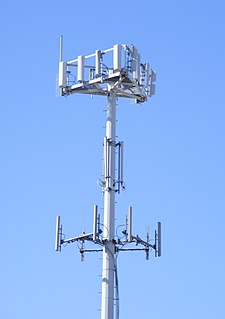
A cell site, cell tower, or cellular base station is a cellular-enabled mobile device site where antennas and electronic communications equipment are placed—typically on a radio mast, tower, or other raised structure—to create a cell in a cellular network. The raised structure typically supports antenna and one or more sets of transmitter/receivers transceivers, digital signal processors, control electronics, a GPS receiver for timing, primary and backup electrical power sources, and sheltering.
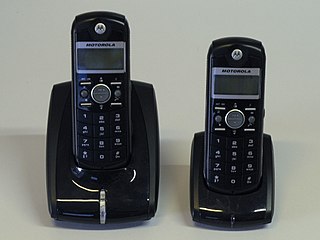
A cordless telephone or portable telephone is a telephone which has a portable handset but which one can use like landline phone communication; such telephones operate using radio-frequency transmission rather than a physical insulated wire or a direct connection to a telephone line. A cordless telephone's base station connects with the telephone network through a telephone line and also includes a charger to charge the handset's batteries. The operational range is limited, usually to the same building or within some short distance from the base station.

An electric shaver is a razor with an electrically powered rotating or oscillating blade. The electric shaver usually does not require the use of shaving cream, soap, or water. The razor may be powered by a small DC motor, which is either powered by batteries or mains electricity. Many modern ones are powered using rechargeable batteries. Alternatively, an electro-mechanical oscillator driven by an AC-energized solenoid may be used. Some very early mechanical shavers had no electric motor and had to be powered by hand, for example by pulling a cord to drive a flywheel.
Energy harvesting is the process by which energy is derived from external sources, captured, and stored for small, wireless autonomous devices, like those used in wearable electronics and wireless sensor networks.
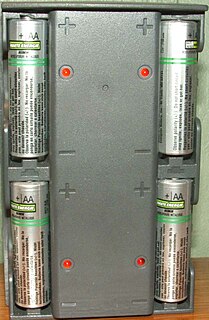
A battery charger, or recharger, is a device that stores energy in a battery by running an electric current through it.

A wireless microphone, or cordless microphone, is a microphone without a physical cable connecting it directly to the sound recording or amplifying equipment with which it is associated. Also known as a radio microphone, it has a small, battery-powered radio transmitter in the microphone body, which transmits the audio signal from the microphone by radio waves to a nearby receiver unit, which recovers the audio. The other audio equipment is connected to the receiver unit by cable. In one type the transmitter is contained within the handheld microphone body. In another type the transmitter is contained within a separate unit called a "bodypack", usually clipped to the user's belt or concealed under their clothes. The bodypack is connected by wire to a "lavalier microphone" or "lav", a headset or earset microphone, or another wired microphone. Most bodypack designs also support a wired instrument connection. Wireless microphones are widely used in the entertainment industry, television broadcasting, and public speaking to allow public speakers, interviewers, performers, and entertainers to move about freely while using a microphone without requiring a cable attached to the microphone.
Standby power, also called vampire power, vampire draw, phantom load, ghost load or leaking electricity, refers to the way electric power is consumed by electronic and electrical appliances while they are switched off or in standby mode. This only occurs because some devices claimed to be "switched off" on the electronic interface, but are in a different state from switching off at the plug, or disconnecting from the power point, which can solve the problem of standby power completely. In fact, switching off at the power point is effective enough, there is no need to disconnect all devices from the power point. Some such devices offer remote controls and digital clock features to the user, while other devices, such as power adapters for disconnected electronic devices, consume power without offering any features. All of the above examples, such as the remote control, digital clock functions and—in the case of adapters, no-load power—are switched off just by switching off at the power point. However, for some devices with built-in internal battery, such as a phone, the standby functions can be stopped by removing the battery instead.

Inductive charging is a type of wireless power transfer. It uses electromagnetic induction to provide electricity to portable devices. Inductive charging is also used in vehicles, power tools, electric toothbrushes, and medical devices. The portable equipment can be placed near a charging station or inductive pad without needing to be precisely aligned or make electrical contact with a dock or plug.

Headsets connect over a telephone or to a computer, allowing the user to speak and listen while keeping both hands free. They are commonly used in customer service and technical support centers, where employees can converse with customers while typing information into a computer. Also common among computer gamers are headsets, which will let them talk with each other and hear others, as well as use their keyboards and mice to play the game.

Wireless speakers are loudspeakers that receive audio signals using radio frequency (RF) waves rather than over audio cables. The two most popular RF frequencies that support audio transmission to wireless loudspeakers include a variation of WiFi IEEE 802.11, while others depend on Bluetooth to transmit audio data to the receiving speaker.

Power management integrated circuits are integrated circuits for power management. Although PMIC refers to a wide range of chips, most include several DC/DC converters or their control part. A PMIC is often included in battery-operated devices such as mobile phones and portable media players to decrease the amount of space required.